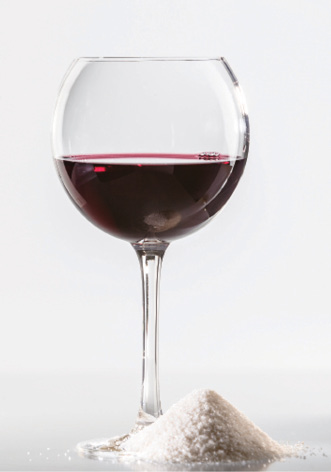
Our job isn’t finished when fermentation is over. With many wines, especially reds, you may want to go ahead and do a malolactic (ML) fermentation as well. And during cellaring you need to keep your sulfite program up to avoid oxidation and spoilage. Along the way, though, you may want to make some other significant changes to your wine prior to bottling. These are deliberate, planned adjustments to the taste in pursuit of specific objectives. Possible changes cover a broad range from simple sweetening to use of special-purpose products like finishing tannins. Throughout the process of flavor adjustment, some key principles prevail. You need to choose the desired outcome, plan how to achieve it, make a timing decision, and finally apply the flavor change.
First, develop a concept. Do you think your wine might be better if a little sweeter? Possibly improved with some oakiness? Want to do something unusual like add fruit flavors or spices? Whatever you have in mind, taste the wine and think creatively about what you experience. Have other people whose palates you trust taste it. Describe your vision for the wine and see what kind of feedback you get.
Depending on the type of adjustment you will undertake, you will choose different times of action. Some additions take place very slowly, like the oak flavor that is imparted to wine through months of barrel aging. Other taste adjustments may need to be made a few weeks before bottling to assure that the wine is stable. When blending two or more wines, for instance, Daniel Pambianchi (in Techniques in Home Winemaking) recommends holding the blend at least four weeks prior to bottling. There are other flavor adjustments that can be made directly in the bottling tank.
Once you have determined what you want to adjust and when you will do it, run a bench trial to confirm your expectations. A trial may not show you exactly how your wine will turn out, but it can help fine-tune your process and prevent a mistake. For your trial, choose two or three possible levels of treatment. Thief out a 100-mL sample for each condition, plus a control. Apply the adjustments, let them stand over night, and taste. In your first trial, you may just be answering the question, “Is my wine better with this adjustment, or without it?” If you decide it is better, you may want to run another trial with more addition levels to fine-tune your plan. However you decide, write down the small-scale result and calculate the needed addition for your full-scale batch.
Sweetness
One of the most straightforward flavor improvements for some wines is sweetening. For either a young rosé or a bright, high-acid white wine, a low but noticeable sweetness can be very enjoyable. Even for “dry” red wine or full-bodied white, a sweetening near taste threshold levels may enhance fruitiness without seeming too sweet. How much sugar is needed will be influenced by the acid level of the wine, as well as other flavor components. High-acid wines can seem dry even at significant sugar concentrations. Typically, sugar levels below about 0.2% (or g/100 mL) are considered “dry.” From about 0.5% to 1.0%, wines are often referred to as “off dry.” From 1% to 2%, they may be called “medium sweet” and above 2% they will usually be designated as sweet.
The natural sugars of grapes are a roughly 50/50 balance of glucose and fructose. With most wine yeasts being glucophilic — preferentially consuming glucose — the low amount of natural sugar that may be left after fermentation is mostly fructose. Fructose is much sweeter in human perception than is glucose, with table sugar (sucrose) somewhere in between. Invert sugar starts as sucrose, which is “inverted” to its component sugars, equal parts fructose and glucose. It tastes somewhat sweeter than sucrose itself. When I sweeten wines, I usually use sucrose. After a trial at perhaps 1%, 2%, and 3%, calculate the amount for your whole batch. Boil the sugar in an equal weight of distilled water to sanitize it and stir into the finished wine. To prevent refermentation, you will also need to add potassium sorbate at a rate of 10 to 20 g/hL (0.4 to 0.8 g/gallon). There are “wine conditioner” products on the market that are already prepared as solutions, making them very easy to use. Made from sucrose, invert sugar, or high-fructose corn syrup, they also contain potassium sorbate or sorbic acid already in solution. While sugar additions can be done just before bottling, better stability is likely if you hold the wine in bulk for a month so any resulting sediment can settle out.
If you want just a slight impression of sweetness, there is a product that does not need a preservative: Gum Arabic. It is most convenient as a liquid preparation that is about 25% gum Arabic, such as Flashgum R Liquide from Scott Laboratories, Stabivin SP from Laffort, or Liqui-Gum from Keller. It is used at rates from about 40 to 150 mL/hL (1.5 to 4 mL/gallon). After determining a suitable amount for your desired flavor in a trial, calculate for the whole batch. Stir directly into the wine in the bottling tank or bucket and bottle. Gum Arabic also helps improve mouthfeel and retards precipitation of colloidal particles in the bottled wine. It should always be the last product addition (along with any needed sulfite) at bottling if it is employed.
Another taste modification that mimics sweetening is reduction of bitterness. Reducing astringency, which is a physical phenomenon rather than a flavor, may also make a wine seem fruitier and rounder. For reducing bitterness or astringency in wine, you can fine it with a protein fining agent. Most commonly, your choices will be natural protein products such as egg whites, gelatin, isinglass, skim milk, and whole milk, plus the synthetic polymer PVPP (polyvinylpolypyrrolidone). All of these reduce astringency (for more details on their use, refer to my February-March 2014 “Techniques” column at http://winemakermag.com/story1360). It is worth noting that the two milk alternatives have a taste advantage over the other proteins for this purpose. In addition to the reduction of tannic astringency, a milk addition will dissolve into the wine a small amount of lactose — milk sugar. Lactose tastes sweet, but is not fermentable by Saccharomyces yeast, so the sugar introduced by the milk fining will not make the wine unstable to refermentation. Reduced astringency and slight sweetening might be just what your wine needs. As with other finings, you will want to leave the wine for a few days to a couple of weeks and then rack off, leaving the protein precipitates behind.
Acid
Pambianchi notes that normal acid levels for dry white wines are usually in the range of 5.0 to 7.5 g/L (0.5 to 0.75 g/100 mL or percent) and 4.0 to 5.5 g/L (0.4 to 0.55 g/100 mL or percent) for dry red wines. If your finished wine has an acid level much higher or lower than these levels, you may want to adjust the taste by adjusting the acid. Even within these ranges, sometimes a wine can taste unusually “sharp” and might benefit from an acid reduction. On the other hand, a wine may taste “flabby” or flat and benefit from an acid increase.
Increasing acid is very easy — just add tartaric acid. For your 100 mL trial samples, adding 0.1 g will give you a 1 g/L equivalent boost. If your wine tastes flat, you might try something like 0.5, 1, and 2 g/L additions to see if you can brighten the taste without making the wine seem too sharp. (For more details on acid adjustment, see Daniel Pambianchi’s “Advanced Winemaking” column in the February-March 2016 issue of WineMaker.) If you do an acid trial and like it, you can scale it up and dissolve the required amount in a small amount of distilled water. Add to the wine a few weeks before bottling. Note that if you add acid to white wine, it may need to undergo another cold stabilization before bottling. Otherwise, tartrate crystals may precipitate later when bottles are chilled. (Red wine carries the same risk, but it is not usually chilled for serving and therefore less likely to present a problem. It may, however, still throw tartrate crystals at cellar temperature — 55 °F or 13 °C — when aged for extended periods of time.)
If you think your wine is too high in acid, there are ways to reduce the level. A good choice for red wines (and a few whites) would be to put the wine through malolactic fermentation if you have not already done so. If that choice is not viable, there are chemical neutralizers that you can employ. The addition of potassium bicarbonate at a rate of 0.66 g/L will reduce tartaric acid by 1 g/L. Adjustment of more than 2 g/L of TA should be avoided due to risk of bitter flavors from excess potassium ion. Potassium carbonate may be used in place of bicarbonate, requiring 0.92 g/L to decrease TA by 1 g/L. For either of these, you should run a trial and make sure no unexpected flavors occur. Then, do the overall adjustment in time to leave a few weeks before bottling. Carbon dioxide gas will be produced in the chemical reaction and other wine components may precipitate and need settling.
Oak
To add oak flavor to your wine, aging in a barrel is most traditional. That requires planning and barrels are expensive. Instead, you may wish to use an “oak alternative” like sticks, staves, spirals, cubes, beans, or chips. Those products usually complete their delivery of oak flavor and aroma in just a few weeks. Even faster is adding a liquid oak extract that has immediate effect. Some prepared tannin products, like Tannin Riche from Scott Laboratories, can also contribute toasty oak flavors. Scott Laboratories recommends allowing at least three weeks after addition to give time for any insoluble material to settle out before bottling. It is difficult to do small-scale trials with wood pieces, but oak extract or finishing tannin can give you quick information on whether or not oak addition improves your wine. If it does, you may choose one of the slower wood products to make the actual addition.
Other flavors
All of the modifications discussed so far are common and conventional ways to adjust the taste of wine. But you are a home winemaker — you don’t have to be conventional! A few years ago when my brother, John Peak, complained that my estate Pinot Noir lacked “oomph,” I made a special wine just for him. To 5 gallons (19 L) of finished Pinot Noir in a 6-gallon (23-L) carboy, I added a 46-ounce (1.4-L) can of Petite Sirah concentrate at 68 °Brix and refermented with a strong yeast. Not only did the alcohol level go up, but color, flavor, and aroma all became more intense as well. If you would like to achieve the flavor and aroma boost without refermenting, you can find natural fruit extracts from sources like blackberries and raspberries at your local home winemaking shop (or online). A 2–4 ounce (29–58 mL) bottle is usually recommended for 5 gallons (19 L) of wine. Once again, do trials to make sure you like the results.
Going even further afield, you may want to consider adding chocolate extract or instant coffee powder to a rich red wine to make a very special dessert-type beverage. A wine like that would probably benefit from sweetening (and sorbate) as well. Spices can be used too. A couple of years ago, my then-colleague at The Beverage People Joe Hanson-Hirt made Christmas presents for the rest of us by turning some homemade Zinfandel into Glüwein or German-style mulled wine. He sweetened the wine, spiced it with orange peel, cinnamon, cloves, and other spices, then filtered it and bottled it. Heated up on a cold winter night it was a real treat and a very different flavor from conventional homemade wine!
The take-home lesson: Keep in mind that your wine is not necessarily finished just because you have completed fermentation. Smell it, taste it, and discuss it with others. If there is improvement to be made — conventional or outlandish — go ahead and do a trial on it. If it works, adjust the flavor of your whole batch. As baseball great Yogi Berra once said, “It ain’t over till it’s over.”







